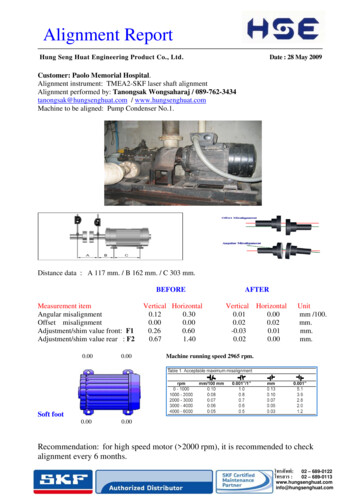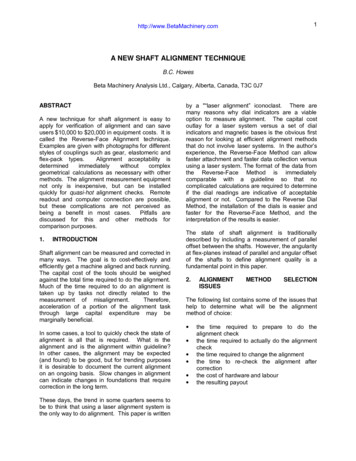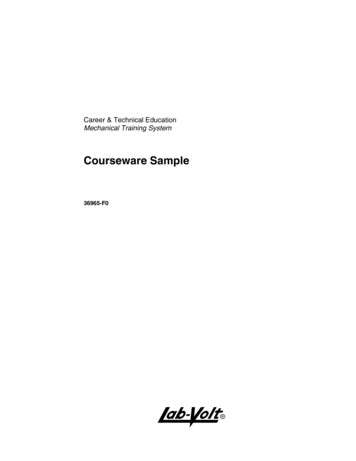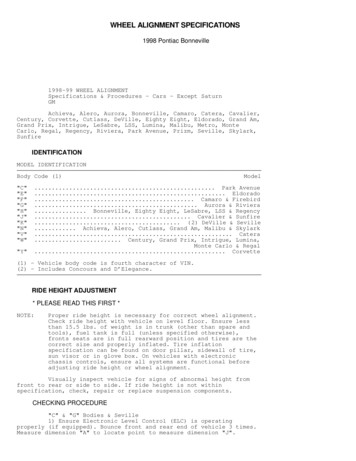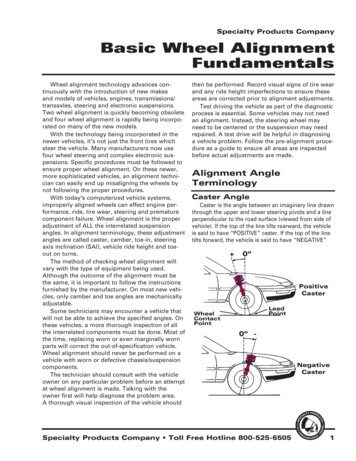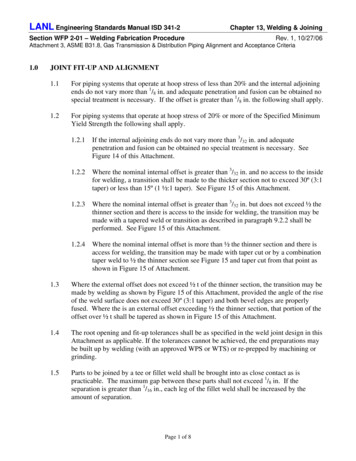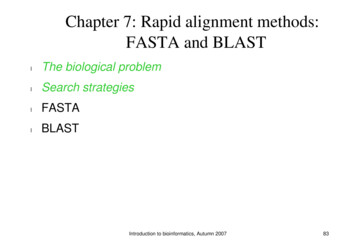
Transcription
Chapter 7: Rapid alignment methods:FASTA and BLASTlThe biological problemlSearch strategieslFASTAlBLASTIntroduction to bioinformatics, Autumn 200783
The biological problem Global and localalignment algoritms areslow in practice Consider the scenario ofaligning a querysequence against a largedatabase of sequences– New sequence withunknown function For instance, the size of NCBIGenBank in January 2007 was65,369,091,950 bases(61,132,599 sequences)Introduction to bioinformatics, Autumn 200784
Problem with large amount ofsequenceslllExponential growth in both number and total length ofsequencesPossible solution: Compare against model organismsonlyWith large amount of sequences, changes are thatmatches occur by random Need for statistical analysisIntroduction to bioinformatics, Autumn 200785
Application of sequence alignment:shotgun sequencinglShotgun sequencing is a method for sequencingwhole-organism genomes First, a large number of short sequences ( 500-1000 bp), orreads are generated from the genome Reads are contiguous subsequences (substrings) of thegenome Due to sequencing errors and repetitions in the reads, thegenome has be covered multiple times by readsIntroduction to bioinformatics, Autumn 200786
Shotgun sequencingOriginal genome sequence ReadsNon-overlappingreadlOrdering of the reads is initially unknownlOverlaps resolved by aligning the readslOverlapping reads ContigIn a 3x109 bp genome with 500 bp reads and 5x coverage, thereare 107 reads and 107(107-1)/2 5x1013 pairwise sequencecomparisonsIntroduction to bioinformatics, Autumn 200787
Shotgun sequencingOriginal genome sequence ReadsNon-overlappingreadlllOverlapping reads Contig 5x1013 pairwise sequence comparisonsRecall that local alignment takes O(nm) time, where n and m aresequence lengthsAlready with n m 500, the computation cost is prohibitiveIntroduction to bioinformatics, Autumn 200788
Search strategieslHow to speed up the computation? lFind ways to limit the number of pairwise comparisonsCompare the sequences at word level to find outcommon words Word means here a k-tuple (or a k-word), a substring oflength kIntroduction to bioinformatics, Autumn 200789
Analyzing the word contentlExample query string I: TGATGATGAAGACATCAGlFor k 8, the set of k-tuples of I isTGATGATGGATGATGAATGATGAATGATGAAG GACATCAGIntroduction to bioinformatics, Autumn 200790
Analyzing the word contentllllThere are n-k 1 k-tuples in a string of length nIf at least one word of I is not found from another stringJ, we know that I differs from JNeed to consider statistical significance:might share words by chance onlyI and JLet n I and m J Introduction to bioinformatics, Autumn 200791
Word lists and comparison by contentllThe k-words of I can be arranged into a table of wordoccurences Lw(I)Consider the k-words when k 2 and I GCATCGGC:GC, CA, AT, TC, CG, GG, GCAT: 3CA: 2CG: 5GC: 1, 7GG: 6TC: 4Start indecies of k-word GC in IBuilding Lw(I) takes O(n) timeIntroduction to bioinformatics, Autumn 200792
Common k-wordslNumber of common k-words in I and J can becomputed using Lw(I) and Lw(J)lFor each word w in I, there are Lw(J) occurences in JlTherefore I and J havecommon wordslThis can be computed in O(n m 4k) time O(n m) time to build the lists O(4k) time to calculate the sumIntroduction to bioinformatics, Autumn 200793
Common k-wordslI GCATCGGClJ CCATCGCCATCGLw(I)AT: 3CA: 2CG: 5GC: 1, 7GG: 6TC: 4Lw(J)AT: 3, 9CA: 2, 8CC: 1, 7CG: 5, 11GC: 6TC: 4, 10Common words220220210 in totalIntroduction to bioinformatics, Autumn 200794
Properties of the common word listlExact matches can be found using binary search (e.g., whereTCGT occurs in I?) lllO(log 4k) timeFor large k, the table size is too large to compute the commonword count in the previous fashionInstead, an approach based on merge sort can be utilised(details skipped, see course book)The common k-word technique can be combined with the localalignment algorithm to yield a rapid alignment approachIntroduction to bioinformatics, Autumn 200795
Chapter 7: Rapid alignment methods:FASTA and BLASTlThe biological problemlSearch strategieslFASTAlBLASTIntroduction to bioinformatics, Autumn 200796
FASTAlllFASTA is a multistep algorithm for sequence alignment (Wilburand Lipman, 1983)The sequence file format used by the FASTA software is widelyused by other sequence analysis softwareMain idea: Choose regions of the two sequences that look promising (have somedegree of similarity) Compute local alignment using dynamic programming in these regionsIntroduction to bioinformatics, Autumn 200797
FASTA outlinelFASTA algorithm has five steps: 1. Identify common k-words between I and J 2. Score diagonals with k-word matches, identify 10 bestdiagonals 3. Rescore initial regions with a substitution score matrix 4. Join initial regions using gaps, penalise for gaps 5. Perform dynamic programming to find final alignmentsIntroduction to bioinformatics, Autumn 200798
Dot matrix comparisonsWord matches in two sequences I and J can be represented asa dot matrixlDot matrix element (i, j) has ”a dot”, if the word starting atposition i in I is identical to the word starting at position j in JlThe dot matrix can be plotted for various kljiiI ATCGGATCA J TGGTGTCGC jIntroduction to bioinformatics, Autumn 200799
k 1k 4Dot matrix (k 1,4,8,16)for two DNA sequencesX85973.1 (1875 bp)Y11931.1 (2013 bp)k 8k 16Introduction to bioinformatics, Autumn 2007100
k 1k 4Dot matrix(k 1,4,8,16) for twoprotein sequencesCAB51201.1 (531 aa)CAA72681.1 (588 aa)k 8k 16Shading indicatesnow the match scoreaccording to ascore matrix(Blosum62 here)Introduction to bioinformatics, Autumn 2007101
Computing diagonal sumslWe would like to find high scoring diagonals of the dot matrixlLets index diagonals by the offset, l i - jJIGCATCGGCC C A T C G C C A T C G**********k 2Diagonal l i – j -6Introduction to bioinformatics, Autumn 2007102
Computing diagonal sumslllAs an example, lets compute diagonal sums for I GCATCGGC, J CCATCGCCATCG, k 21. Construct k-word list Lw(J)2. Diagonal sums Sl are computed into a table, indexed with theoffset and initialised to zerol -10 -9 -8 -7 -6 -5 -4 -3 -2 -1 0 1 2 3 4 5 6Sl0000000000 0 0 0 0 0 0 0Introduction to bioinformatics, Autumn 2007103
Computing diagonal sumsl3. Go through k-words of I, look for matches in Lw(J) and updatediagonal sumsJIGCATCGGCC C A T C G C C A T C G*********For the first 2-word in I,GC, LGC(J) {6}.We can then updatethe sum of diagonall i – j 1 – 6 -5 toS-5 : S-5 1 0 1 1*Introduction to bioinformatics, Autumn 2007104
Computing diagonal sumsl3. Go through k-words of I, look for matches in Lw(J) and updatediagonal sumsJIGCATCGGCC C A T C G C C A T C G**********Next 2-word in I is CA,for which LCA(J) {2, 8}.Two diagonal sums areupdated:l i–j 2–2 0S0 : S0 1 0 1 1I i – j 2 – 8 -6S-6 : S-6 1 0 1 1Introduction to bioinformatics, Autumn 2007105
Computing diagonal sumsl3. Go through k-words of I, look for matches in Lw(J) and updatediagonal sumsJIGCATCGGCC C A T C G C C A T C G**********Next 2-word in I is AT,for which LAT(J) {3, 9}.Two diagonal sums areupdated:l i–j 3–3 0S0 : S0 1 1 1 2I i – j 3 – 9 -6S-6 : S-6 1 1 1 2Introduction to bioinformatics, Autumn 2007106
Computing diagonal sumsAfter going through the k-words of I, the result is:l -10 -9 -8 -7 -6 -5 -4 -3 -2 -1 0 1 2 3 4 5 6Sl0000410000 4 1 0 0 0 0 0JIGCATCGGCC C A T C G C C A T C G**********Introduction to bioinformatics, Autumn 2007107
Algorithm for computing diagonal sum of scoresSl : 0 for all 1 – mln–1Compute Lw(J) for all words wfor i : 1 to n – k – 1 dow : IiIi 1 Ii k-1for jLw(J) dol : i – jSl : Sl 1Match score is here 1endendIntroduction to bioinformatics, Autumn 2007108
FASTA outlinelFASTA algorithm has five steps: 1. Identify common k-words between I and J 2. Score diagonals with k-word matches, identify 10 bestdiagonals 3. Rescore initial regions with a substitution score matrix 4. Join initial regions using gaps, penalise for gaps 5. Perform dynamic programming to find final alignmentsIntroduction to bioinformatics, Autumn 2007109
Rescoring initial regionslEach high-scoring diagonal chosen in the previous step isrescored according to a score matrixlThis is done to find subregions with identities shorter than klNon-matching ends of the diagonal are trimmedI: C C A T C G C C A T C GJ: C C A A C G C A A T C A75% identity, no 4-word identitiesI’: C C A T C G C C A T C GJ’: A C A T C A A A T A A A33% identity, one 4-word identityIntroduction to bioinformatics, Autumn 2007110
Joining diagonalslTwo offset diagonals can be joined with a gap, if the resultingalignment has a higher scorelSeparate gap open and extension are usedlFind the best-scoring combination of diagonalsHigh-scoringdiagonalsTwo diagonalsjoined by a gapIntroduction to bioinformatics, Autumn 2007111
FASTA outlinelFASTA algorithm has five steps: 1. Identify common k-words between I and J 2. Score diagonals with k-word matches, identify 10 bestdiagonals 3. Rescore initial regions with a substitution score matrix 4. Join initial regions using gaps, penalise for gaps 5. Perform dynamic programming to find final alignmentsIntroduction to bioinformatics, Autumn 2007112
Local alignment in the highest-scoringregion Last step of FASTA: perform localalignment using dynamic programmingaround the highest-scoring Region to be aligned covers –w and w offset diagonal to the highestscoring diagonals With long sequences, this region istypically very small compared to thewhole n x m matrixwwDynamic programming matrixM filled only for the green regionIntroduction to bioinformatics, Autumn 2007113
Properties of FASTAlFast compared to local alignment using dynamic programmingonly llOnly a narrow region of the full matrix is alignedIncreasing parameter k decreases the number of hits: increasesspecificity, decreases sensitivityFASTA can be very specific when identifying long regions oflow similarity Specific method does not produce many incorrect results Sensitive method produces many of the correct resultsIntroduction to bioinformatics, Autumn 2007114
Properties of FASTAlFASTA looks for initial exact matches to querysequence Two proteins can have very different amino acid sequencesand still be biologically similar This may lead into a lack of sensitivity with divergedsequencesIntroduction to bioinformatics, Autumn 2007115
Demonstration of FASTA at EBIllhttp://www.ebi.ac.uk/fasta/Note that parameter ktup in the software correspondsto parameter k in lecturesIntroduction to bioinformatics, Autumn 2007116
Introduction to bioinformatics, Autumn 2007 97 FASTA l FASTA is a multistep algorithm for sequence alignment (Wilbur and Lipman, 1983) l The sequence file format used by the FASTA software is widely used by other sequence analysis software l Main idea: Choose regions of the two sequences that look promising (ha

